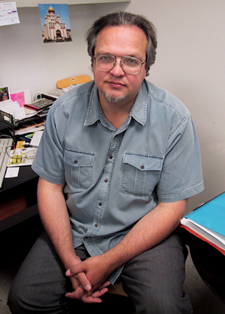Dr. Vladimir A. Mironov
The NewScientist article Ink-jet printing creates tubes of living tissue said
“Three-dimensional tubes of living tissue have been printed using modified desktop printers filled with suspensions of cells instead of ink. The work is a first step towards printing complex tissues or even entire organs.‘This could have the same kind of impact that Gutenberg’s press did,’ claims tissue engineer Vladimir Mironov of the Medical University of South Carolina.
Many labs can now print arrays of DNA, proteins or even cells. But for tissue engineers, the big challenge is creating three-dimensional structures. Mironov became interested when Thomas Boland of Clemson University, also in South Carolina, told Mironov how he could print biomaterials using modified ink-jet printers.
The printers are adapted by washing out the ink cartridges and refilling them with suspensions of, say, cells. The software that controls the viscosity, electrical resistances and temperature of the printing fluids is reprogrammed and the feed systems altered.”
Vladimir A. Mironov, M.D., Ph.D. is Assistant Professor, Department of Cell Biology and Anatomy, MUSC (Medical University of South Carolina). His research interests are cardiovascular development, vascular biology, tissue engineering, and phenomics.
Vladimir coedited Vascular Morphogenesis: in Vivo, in Vitro, in Mente, coauthored Regaining chondrocyte phenotype in thermosensitive gel culture, Organ printing: computer-aided jet-based 3D tissue engineering, Patterning of embryonic blood vessels, Expression of smooth muscle alpha-actin in mesenchymal cells during formation of avian endocardial cushion tissue: A role for transforming growth factor β3, and Engineering biological structures of prescribed shape using self-assembling multicellular systems, and authored the innovative Amazon download Beyond cloning: toward human printing.
He earned his MD in Medical Sciences at Ivanovo St. Medical Inst. in 1977 and his PhD in Histology/Embryology at Moscow Pirogov St Med Inst in 1980.
